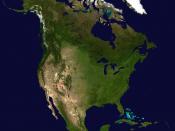Archetypal Analysis of Early Symbols
While researching the early symbols of mankind, I found that there were many that appeared in various regions of the world. The interesting part, however, was that some had meaning that was essentially the same across the globe, even in places whose cultures had obviously never met. These symbols are archetypal; part of the collective unconscious we are all born with. It is for this reason that two prehistoric humans could come up with them and interpret them in the same ways at completely opposite points of the globe. The symbols can be divided into two major groups, those being environmental symbols and shapes.
Virtually all archetypal symbols originate when humans see them in nature. However there are some symbols that are simply objects in nature, such as fish. The picture to the right is one of a cave painting made by aborigines in Australia of a fish.
The picture below it is also of an early fish drawing, this one made by pagans in northern Europe. Fish and other animals represented the people's reliance on nature and their prey, but also is an archetypal symbol of fertility for it lives in water. Water is one the biggest archetypal symbols in existence. Water represents birth, rebirth, the mother archetype, and the unconscious. The water archetype, however, being somewhat difficult to depict pictorially, was mostly expressed verbally, in myths. Many mythologies, such as the Sioux of North America, the Norse, the Chinese, and the Nigerian, have creation myths that start with the Earth being a huge primal lake or simply covered in water and from that land and life arises. The archetypes in water prove more than any other how the collective unconscious, including archetypes, are within every human being's mind from the day they are...


